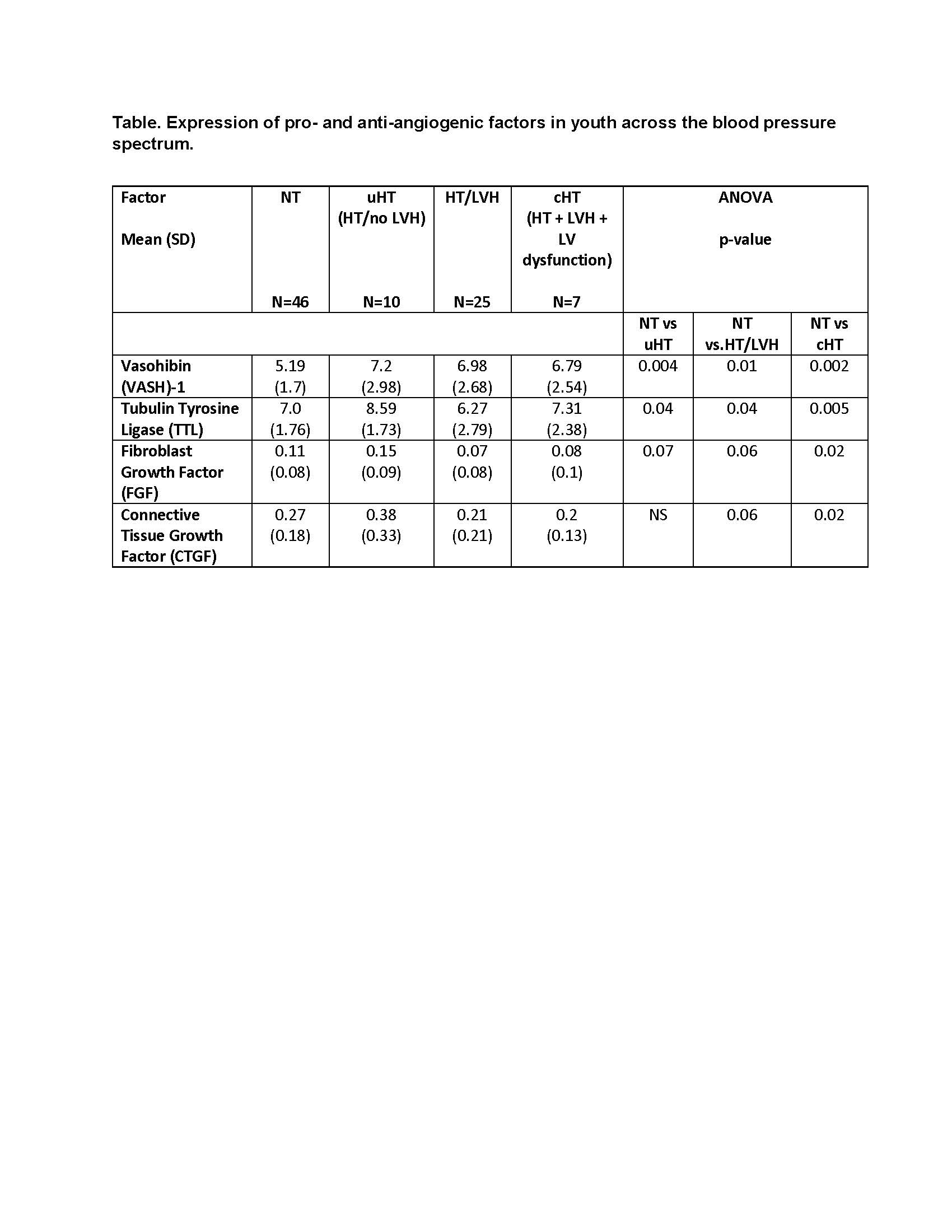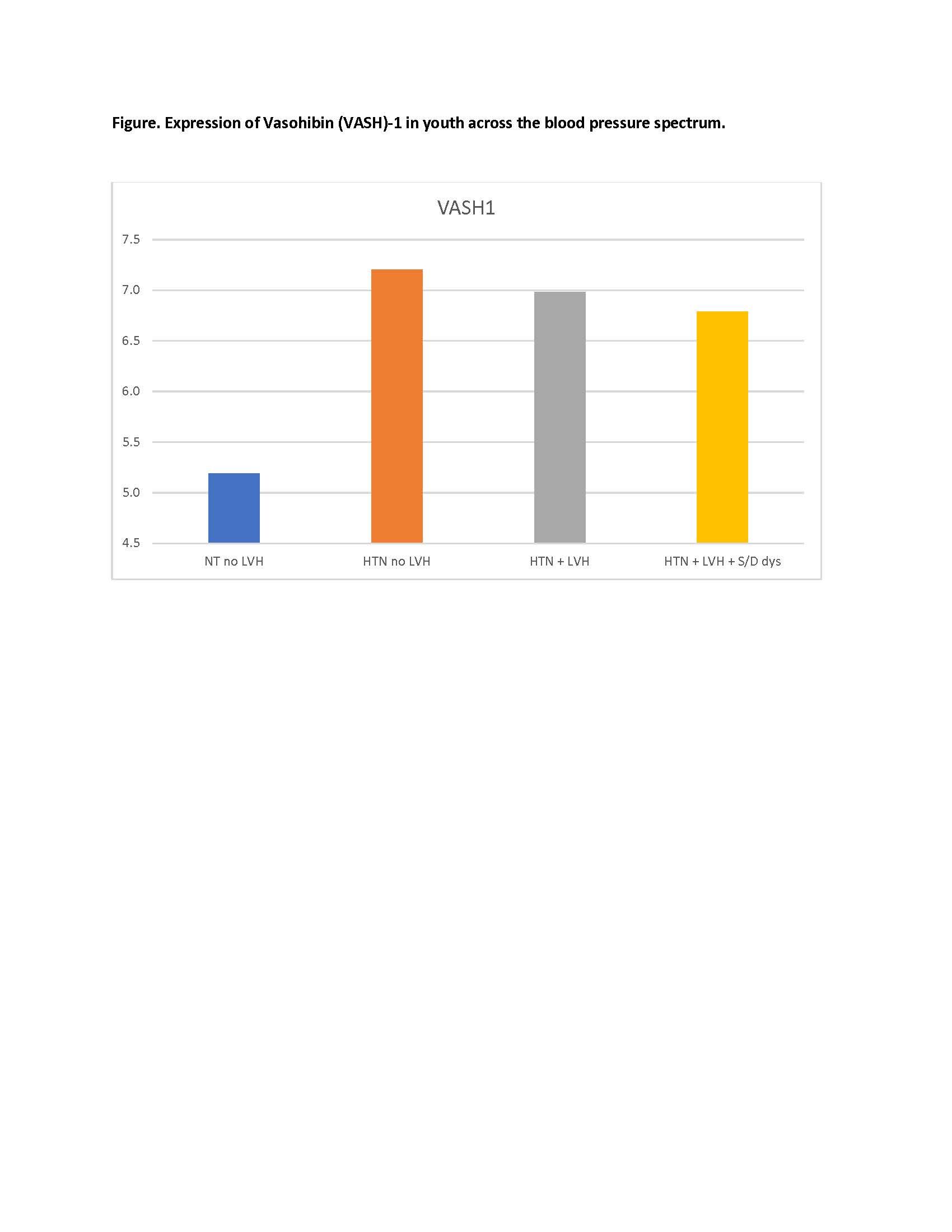Hypertension
Category: Abstract Submission
Hypertension I
82 - Differential Expression of Circulatory Factors among Youth with Hypertension and Target Organ Damage: The SHIP AHOY STUDY
Sunday, April 24, 2022
3:30 PM - 6:00 PM US MT
Poster Number: 82
Publication Number: 82.324
Publication Number: 82.324
Tammy M. Brady, Johns Hopkins University, Baltimore, MD, United States; Sakthivel Sadayappan, University of Cincinnati, Cincinnati, OH, United States; Michael A. Ferguson, Harvard Medical School, Boston, MA, United States; Marc Lande, Golisano Children's Hospital at The University of Rochester Medical Center, Rochester, NY, United States; Kevin E. Meyers, Childrens Hospital of Philadelphia, Philadelphia, PA, United States; Joshua Samuels, McGovern Medical School at UTHealth, Houston, TX, United States; Joseph Flynn, University of Washington School of Medicine, seattle, WA, United States; Elaine M. Urbina, Cincinnati Children's Hospital Medical Center, Cincinnati, OH, United States
- TB
Tammy M. Brady, MD, PhD (she/her/hers)
Associate Professor of Pediatrics
Johns Hopkins University
BALTIMORE, Maryland, United States
Presenting Author(s)
Background: Prior to cardiovascular (CV) events, biological adaptations occur to protect against the shear stress of persistent hypertension (HTN). In response to increased arterial pressure, cardiomyocytes secrete pro- and anti-angiogenic factors to prevent hypoxia and fibrosis. Over time, these changes become maladaptive and pathologic, leading to target organ damage (TOD) such as left ventricular (LV) hypertrophy (LVH) and LV dysfunction.
Objective: Determine the levels of pro- and anti-angiogenic factors present in youth with CV disease phenotypes across the blood pressure spectrum (normotension [NT], uncomplicated HTN without TOD [uHT], HTN with LVH [HT/LVH] and complicated HTN with LVH and systolic or diastolic dysfunction [cHT]).
Design/Methods: Participants categorized into one of 4 blood pressure (BP)/TOD phenotypes were included from a study exploring BP thresholds predictive of TOD in adolescents. Clinic, ambulatory BP, echocardiography and peripheral blood nucleated cells (PBNCs) were collected. BP was categorized per the 2017 American Academy of Pediatrics Clinical Practice Guidelines. LVH was defined as LV mass index>38.6 g/m2.7 (pediatric definition); LV dysfunction was defined as Global Longitudinal Strain≥ -17% &/or E/e’≥ 7.5 (90th% for lean healthy youth). Molecular and pathway analysis was performed using DNA, RNA and protein samples isolated from PBNCs by global DNA methylation with DNA Methylation IP Kit and Illumina HiSeq, RNA-Seq and miRNA-Seq with Illumina HiSeq2500 and nanoscale reverse phase chromatography and tandem mass spectrometry. ANOVA compared factor levels between groups.
Results: 88 participants (mean age 15.9 (±1.5) yrs; 57% male, 64% White, 24% Black, 12% Other) had samples analyzed. 46 had NT, 10 had uHT, 25 had HT/LVH, 7 had cHT. Vasohibin (VASH)-1, an endothelial-derived angiogenesis inhibitor, Fibroblast Growth Factor (FGF), a hormone involved in bone mineral metabolism, and connective tissue growth factor (CTGF), a protein with pro- and anti-angiogenic functions, were differentially expressed in youth with HTN and TOD; tubulin tyrosine ligase (TTS), a tyrosinating enzyme associated with increased cardiac relaxation, was not (Table and Figure).Conclusion(s): Among adolescents with CV phenotypes across the blood pressure spectrum, several circulatory pro- and anti-angiogenic factors were differentially expressed. Future studies are needed to determine whether upregulation of these factors in endothelial cells and cardiomyocytes is directly associated with development of TOD.
Expression of pro- and anti-angiogenic factors in youth across the blood pressure spectrum.
Expression of Vasohibin (VASH)-1 in youth across the blood pressure spectrum.
Objective: Determine the levels of pro- and anti-angiogenic factors present in youth with CV disease phenotypes across the blood pressure spectrum (normotension [NT], uncomplicated HTN without TOD [uHT], HTN with LVH [HT/LVH] and complicated HTN with LVH and systolic or diastolic dysfunction [cHT]).
Design/Methods: Participants categorized into one of 4 blood pressure (BP)/TOD phenotypes were included from a study exploring BP thresholds predictive of TOD in adolescents. Clinic, ambulatory BP, echocardiography and peripheral blood nucleated cells (PBNCs) were collected. BP was categorized per the 2017 American Academy of Pediatrics Clinical Practice Guidelines. LVH was defined as LV mass index>38.6 g/m2.7 (pediatric definition); LV dysfunction was defined as Global Longitudinal Strain≥ -17% &/or E/e’≥ 7.5 (90th% for lean healthy youth). Molecular and pathway analysis was performed using DNA, RNA and protein samples isolated from PBNCs by global DNA methylation with DNA Methylation IP Kit and Illumina HiSeq, RNA-Seq and miRNA-Seq with Illumina HiSeq2500 and nanoscale reverse phase chromatography and tandem mass spectrometry. ANOVA compared factor levels between groups.
Results: 88 participants (mean age 15.9 (±1.5) yrs; 57% male, 64% White, 24% Black, 12% Other) had samples analyzed. 46 had NT, 10 had uHT, 25 had HT/LVH, 7 had cHT. Vasohibin (VASH)-1, an endothelial-derived angiogenesis inhibitor, Fibroblast Growth Factor (FGF), a hormone involved in bone mineral metabolism, and connective tissue growth factor (CTGF), a protein with pro- and anti-angiogenic functions, were differentially expressed in youth with HTN and TOD; tubulin tyrosine ligase (TTS), a tyrosinating enzyme associated with increased cardiac relaxation, was not (Table and Figure).Conclusion(s): Among adolescents with CV phenotypes across the blood pressure spectrum, several circulatory pro- and anti-angiogenic factors were differentially expressed. Future studies are needed to determine whether upregulation of these factors in endothelial cells and cardiomyocytes is directly associated with development of TOD.
Expression of pro- and anti-angiogenic factors in youth across the blood pressure spectrum.

Expression of Vasohibin (VASH)-1 in youth across the blood pressure spectrum.

